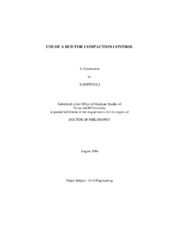| dc.contributor.advisor | Briaud, Jean-Louis | |
| dc.creator | Li, Yanfeng | |
| dc.date.accessioned | 2005-11-01T15:49:41Z | |
| dc.date.available | 2005-11-01T15:49:41Z | |
| dc.date.created | 2004-08 | |
| dc.date.issued | 2005-11-01 | |
| dc.identifier.uri | https://hdl.handle.net/1969.1/2696 | |
| dc.description.abstract | Compaction of soil is essential in the construction of highways, airports, buildings, and bridges. Typically compaction is controlled by measuring the dry density and the water content of the compacted soil and checking that target values have been achieved. There is a current trend towards measuring the soil modulus instead or in addition to density. The reasons are that the density measurements are made using nuclear density meter, an undesirable tool in today??s political environment and that pavement design uses moduli as an input parameter. Although there are many apparatus available to measure soil modulus in the field such as Falling Weight Deflectometer, Dynamic Cone Penetrometer and Seismic Pavement Analyzer, a light weight and easy to use device which can measure the soil modulus fast and accurately is in great need. Briaud Compaction Device (BCD) is a portable device which can measure a soil modulus in several seconds. The principle of the BCD is to use the bending of a plate resting on the ground surface as an indicator of the modulus of the soil below. Numerical simulations show that within a certain range, the soil modulus is simply related to the plate bending. Strain gauges are glued on the top of the plate of BCD and a double half Wheatstone bridge is used to measure the strain. BCD tests were done in parallel with plate tests of the same size. A good correlation was found between the ratio of the plate pressure over the bending strain measured with a BCD and the reload soil modulus obtained from the plate test. This correlation can be incorporated into the BCD processor to display the soil modulus directly. To transit from dry density based compaction control to modulus based compaction control, BCD tests were also performed in the laboratory on top of a soil sample compacted inside the Proctor mold followed by plate tests. That way, a soil modulus versus water content curve is developed which parallels the approach for the dry density versus water content. The soil modulus versus water content curve can be used to provide the target values for compaction control in the field. | en |
| dc.format.extent | 4296216 bytes | en |
| dc.format.medium | electronic | en |
| dc.format.mimetype | application/pdf | |
| dc.language.iso | en_US | |
| dc.publisher | Texas A&M University | |
| dc.subject | Compaction Control | en |
| dc.subject | Soil Modulus | en |
| dc.subject | Density | en |
| dc.subject | Water Content | en |
| dc.subject | Plate Test | en |
| dc.subject | Strain | en |
| dc.title | Use of a BCD for compaction control | en |
| dc.type | Book | en |
| dc.type | Thesis | en |
| thesis.degree.department | Civil Engineering | en |
| thesis.degree.discipline | Civil Engineering | en |
| thesis.degree.grantor | Texas A&M University | en |
| thesis.degree.name | Doctor of Philosophy | en |
| thesis.degree.level | Doctoral | en |
| dc.contributor.committeeMember | Mathewson, Christopher C. | |
| dc.contributor.committeeMember | Jones, Harry L. | |
| dc.contributor.committeeMember | Murff, James D. | |
| dc.type.genre | Electronic Dissertation | en |
| dc.type.material | text | en |
| dc.format.digitalOrigin | born digital | en |


